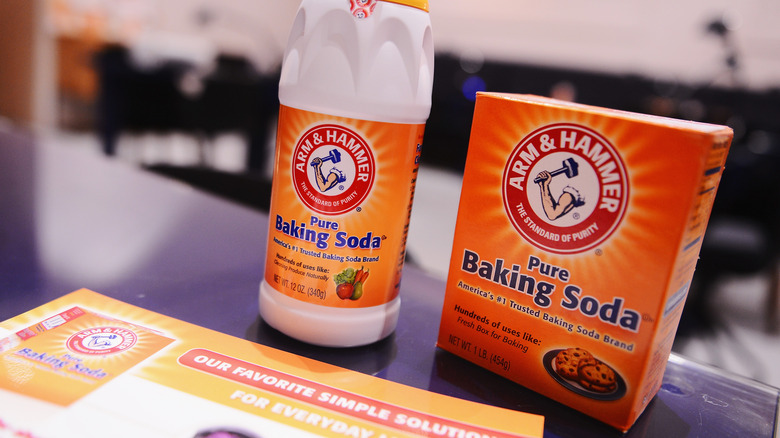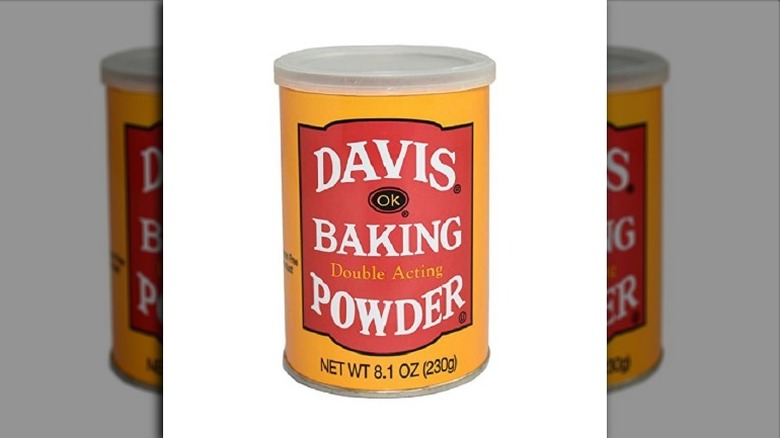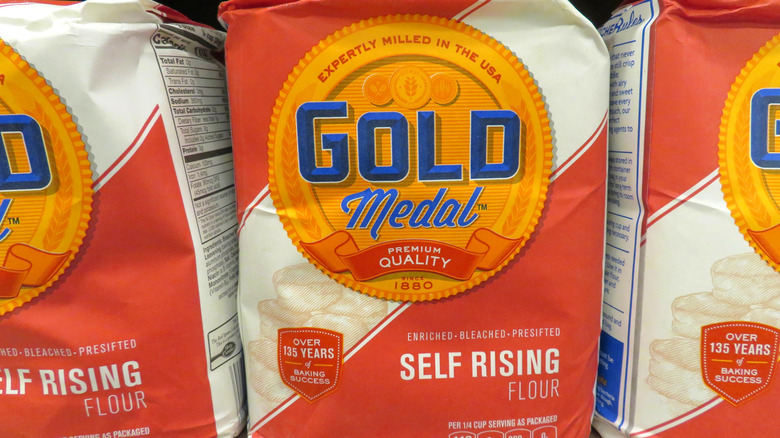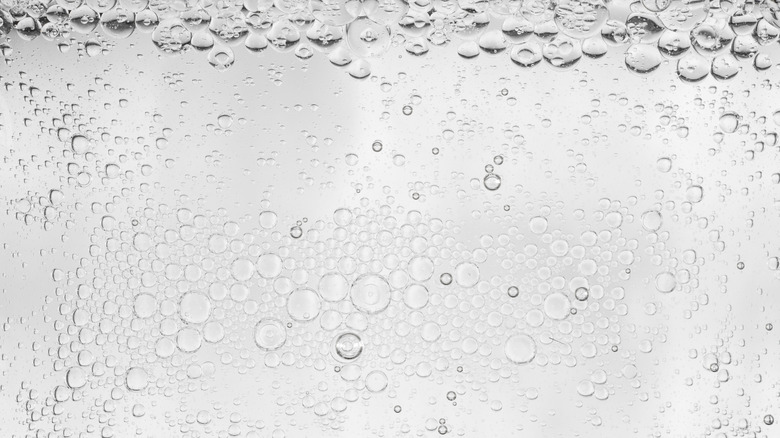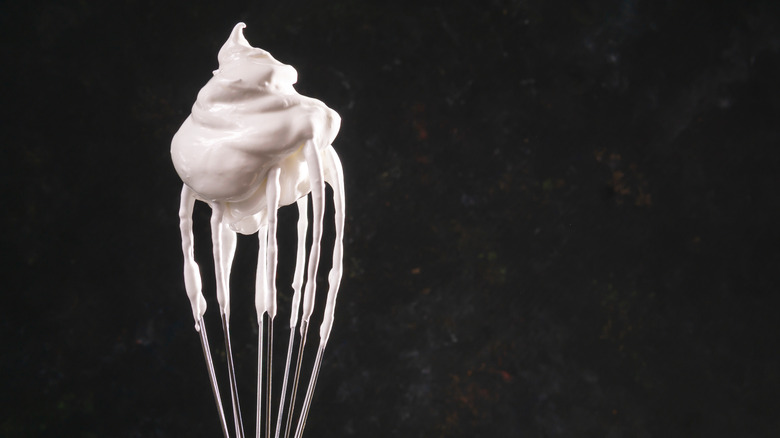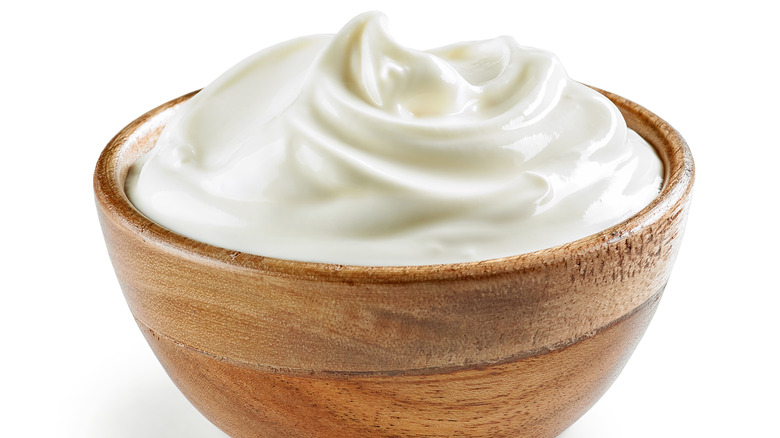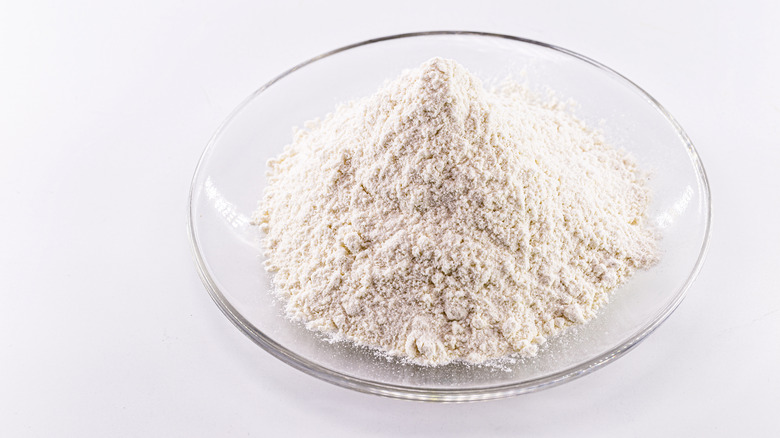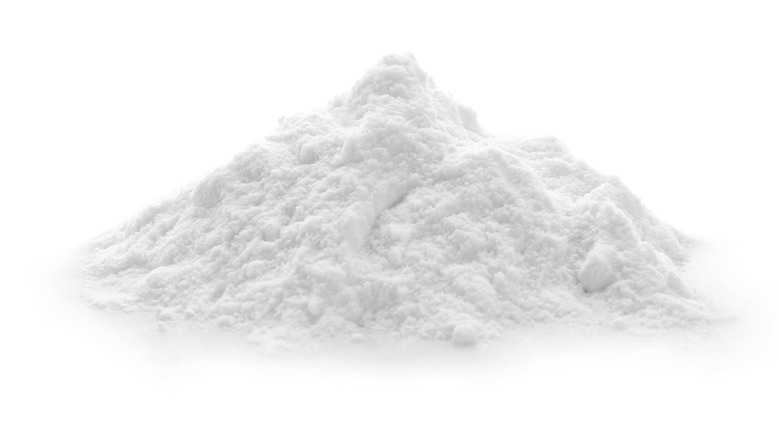Best Baking Soda Substitutes That Actually Work
We may receive a commission on purchases made from links.
From the omnipresent box in the fridge to the teaspoonful that helps your cookies and cakes rise, baking soda is certainly a kitchen mainstay. Also known as sodium bicarbonate, it is a naturally alkaline (read: basic, aka non-acidic) substance (via Everyday Health). When combined with an acid, like vinegar, this unassuming white powder causes an explosive reaction that has animated no small number of volcanic science fair projects.
In addition to its ability to stand in for magma, baking soda is a bit of a culinary superhero. It can leaven baked goods, neutralize stomach acid, wick away odors, remove stubborn stains, and more.
Since a box of baking soda lasts a pretty long time (about 18 months, according to the USDA), it's rarely on weekly shopping lists, and that means that home cooks can occasionally be confronted with a recipe calling for a scant ⅛ teaspoon of the stuff, only to find the cupboards bare of that familiar orange box. So, what should you do when you're halfway through a pancake, biscuit, or cookie recipe sans baking soda? Well, first off, don't panic. And second, seek out a substitute from our list below.
Baking powder
Baking soda's superpower as a leavening agent comes from its innate potential for chemical reaction. As we mentioned earlier, when it joins forces with an acid, like vinegar, yogurt, buttermilk, or non-alkalized cocoa, baking soda naturally reacts, producing carbon dioxide bubbles in the dough or batter. Far from the explosions of many a childhood science fair, this chemical reaction merely helps the cake or cookie to rise.
If you find yourself devoid of baking soda, there is an easy shortcut: another kitchen staple that already contains baking soda! Baking powder is a combination of baking soda and cream of tartar — in other words, baking powder already has the acidic component, well, baked in (har har). Recipes that don't call for an acid, like chocolate chip cookies, often call for baking powder instead of baking soda for just this reason.
Subbing baking powder for baking soda, however, isn't a question of a 1:1 replacement. Baking soda is a lot stronger than baking powder — about four times as strong, according to Bon Appétit. While Bon Appétit doesn't recommend swapping baking powder with baking soda for just this reason, The Kitchn notes that, in a pinch, a 3:1 sub of powder for soda may get you out of a baking bind as long as you remember to also reduce the acid in your recipe. Consider swapping milk for buttermilk or using Dutch process cocoa instead of natural to reduce the recipe's acidity and get the flavor you're looking for.
Self-rising flour
Another cupboard staple with baking soda baked right in is self-rising flour. Made with a combination of regular flour, baking powder, and salt, self-rising flour leavens naturally and can therefore be a helpful tool if you're out of baking soda.
Self-rising flour does impose a certain ratio of baking powder set by the manufacturer, making substitutions a bit more difficult. Our Everyday Life offers the solution of using a 1:1 replacement of the flour called for in your recipe, as well as a de-acidification of the batter or dough itself (i.e. replacing buttermilk with milk or natural cocoa with Dutch-processed). You may also want to reduce the salt slightly to account for the seasoning already present in the flour.
Our Everyday Life also warns that your baked good may not achieve the lovely brown color you're looking for with this swap, so it's best used in items that you can brush with egg wash or butter (such as biscuits) to achieve that sought-after golden hue.
Club soda
Much like baking soda, not only can club soda be used for the swift removal of stains (seriously, sweat stains on white t-shirts didn't know what was coming), but this fizzy drink can also provide leavening to baked goods. The only caveat? As a liquid, club soda adds quite a bit more moisture to your dough, making this a major no-no for recipes like cookies that don't already have a liquid component.
For best results, use club soda as a substitute for baking soda in a recipe that already calls for liquid, like pancakes or a quick bread recipe that uses citrus juice. Swap a portion of the liquid for an equal volume of club soda, and you're good to go! Note that, of course, club soda won't have the aroma of the original liquid in your recipe, so this swap is best in batters or doughs that have other rich flavors, like chocolate or coffee.
Beaten egg whites
Before chemical leavening agents were even a thing, voluminous baked goods like angel food cake or chiffon cake often relied on the protein structure of egg whites to achieve their lighter-than-air texture. By beating egg whites vigorously, you don't just get a major arm workout — you can actually trap air bubbles, lending lightness to baked goods without the need for any baking soda at all.
If you opt for this solution, you'll have to begin with a recipe that already uses eggs, like a pound cake or pancakes. Instead of adding whole eggs to the batter, separate them, adding the yolks on their own and beating the egg whites to stiff peaks separately. Then, gently fold the egg whites into the otherwise finished batter. The texture might not be quite the same as if you'd used baking soda, but your finished cake won't be too dense, either.
Whipped cream
Much like eggs, cream can also be beaten to trap air bubbles in it — think the perfect fluffy whipped cream atop a cake. And according to Ree Drummond of the Pioneer Woman, whipped cream can also go into your cake!
For Drummond, this substitution is best suited for simple recipes like pancakes or denser goods like cookies whose texture won't be too impeded without the lift that baking soda usually provides. If you're going this route, simply sub an equal volume of cream for the milk, yogurt, or buttermilk called for in the original recipe, and whip it to stiff peaks. Fold the whipped cream into the batter gently to keep it from falling and spoiling all your hard work. Remember that if your original recipe called for a touch of acid — like buttermilk or yogurt — you may want to add a drizzle of lemon juice to achieve a similar tang in the finished product.
Potassium bicarbonate
Baking soda's name provides a hint at one of its major components: sodium. An eighth of a teaspoon of baking soda contains a whopping 150 milligrams of sodium — nearing the lower end of the 180 to 500 milligrams we need daily, according to U.S. Dietary Guidelines. And while you'd generally have to eat an entire recipe of cookie dough to consume that much baking soda in one fell swoop, if you've been told by your doctor to follow a low-sodium diet, you may be on the lookout for alternatives. One low-salt alternative? Potassium bicarbonate, which you can sub in an equal volume for baking soda. It's certainly not a pantry staple, but it's easy enough to find online.
Once you've stocked it, even household members for whom sodium is not a big problem are in luck: Use potassium bicarbonate in place of the baking soda a recipe calls for, and add a pinch of salt, too. No one will be the wiser.
Baker's ammonia
Before there was baking soda, there was baker's ammonia (aka ammonium carbonate), which Healthline reports has been used as a leavening agent since the 13th century. (Also a fun fact: It's another name for smelling salts!) Known for its ability to create a lovely crispy texture in baked goods, baker's ammonia is best in recipes like crackers or thin, crisp cookies rather than fluffy cakes or pancakes. The reason behind that is the ammonia evident in this ingredient's name may become trapped inside denser baked goods, imparting an unfortunate bleachy aroma — not exactly appetizing to cut into a cake and smell surface cleaner!
If you are baking up a crispier treat, however, the good news about this sub is that it couldn't be easier: Just swap an equal volume of baker's ammonia for the baking soda called for in the recipe, and you'll be good to go.
